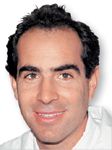Article
PVP laser found safe, efficacious in relieving LUTS
Honolulu--Photoselective vaporization of the prostate (PVP) is a safe, efficacious approach to relieve lower urinary tract symptoms, according to a study presented at the annual Kimbrough Urological Seminar here. PVP engenders minimal morbidity while achieving significant cost savings, said study author Robert E. Reiter, MD.

The study joins a growing body of clinical evidence on high-powered lasers, the vast majority of which arrives at similar conclusions.
"I offer my patients a panoply of treatments and review the pros and cons of each. When they come to make a choice, virtually all opt for this," said Dr. Reiter professor urology at UCLA. "I don't do [transurethral resection of the prostate] anymore."
"I wanted to do this study for two reasons," Dr. Reiter said. "First, I wanted to get a first-hand look at the results and get an idea of quality-of-life outcomes. Second, I wanted to see what the costs were compared with TURP.
"One of the claims being made is that, because the procedure was minimally invasive with minimal morbidity, it was less expensive. But I have never seen data supporting this claim."
No significant complications None of the 50 men in the study experienced significant intraoperative or postoperative complications, nor did any patient show significant changes in serum sodium hemoglobin or hematocrit. Three patients experienced postoperative bleeding. Two of these who had glands >80 grams required reoperation to remove residual tissue. One had a stricture that required surgical opening.
None of the 50 patients in the study had postoperative bleeding requiring transfusion. Mean catheterization time was 14 hours (range, 0 to 24 hours) with up to one-third of the patients having catheters removed in recovery. Close to two-thirds (60%) were sent home on the day of the procedure.
Dr. Reiter said the indications for the 80-watt KTP laser were similar to those for TURP. He said the procedure has no significant contraindications, but patients with larger prostates (>80 grams) should be approached with a degree of caution, particularly if the surgeon has not had significant experience with the device.
Eighteen of the patients in the series had glands 80 grams or larger. Of the three patients who presented with delayed hematuria, two had larger glands.
"My advice is to avoid lasing anything within the bladder or bladder mucosa. It can lead to dysuria. That was a problem with the early lasers," Dr. Reiter said. "We looked at that pretty carefully. Only one patient in our series had dysuria, and I think it can be avoided by staying out of the bladder."
Dr. Reiter also noted that the majority of the patients who remained in the hospital overnight were treated at the start of the study, were older men, and had larger glands.
"I'm sending almost all patients home now unless they have a very large gland treated. Those who go home the day of the procedure are usually held for 4 to 6 hours, and most go home without a catheter," he said.
The side-firing laser is not just a high-powered laser, Dr. Reiter explained. The power to vaporize tissue rather than cut it requires learning new techniques.
"I would say I began to feel reasonably proficient doing straight-forward procedures after five to 10 cases. It will probably take more than that for most surgeons to do complex cases such as large prostates," he said.


